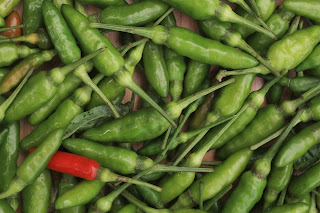We Bhutanese pride ourselves as a nation of Ema Datsi. We eat chilies for breakfast, lunch, dinner and snack on it at odd hours. But how much do we really know about this hot stuff that ranks as our most favorite item of food? We are so desperate for chilies that we unfailingly smuggle in chilies during our overseas trips - even while fully in the know that we could be fined heavily, if caught with the hot stuff. Shortage of chilies in the country is a national crisis - we can be driven to such desperation that in 2017, the erstwhile PDP government imported chilies by Druk Air.
Druk Hotel's Chef Kundu's Ema Datsi prepared from green chilies
I suspect that we consume over 14,000,000 KGs of chilies a year. And yet, until about a year back, we were talking of importing 200 truckloads of chilies from India. The situation has now improved and we are more or less self sufficient in chilies.
During the chili season, even open fields are taken up for drying chilies
There are over 2,000 - 3,000 chili varieties cultivated around the world, in addition to the wild varieties. How many varieties do we grow in Bhutan? No idea – but the following are what I have seen in Thimphu Centenary Farmers’ Market. Unfortunately I do not know the names. Perhaps some readers could fill in the names of these varieties. The only thing I know is that more chili varieties seems to be grown in the Southern parts of the country, compared to the Northern parts.
This is called Dulley Khorsani - one of the hottest varieties originating in the South of the country
This variety of chili grown in the North of the country seems to be the chili of choice for preparing Ema Datsi
Pakshikha Ema - This chili variety comes from Pakshikha, Bongo Gewog. They claim that this is among the hottest and tastiest of all chili variety found in Bhutan
Some chili varieties arranged in order of size
Generally only ripe red chilies are sun-dried. After drying, they come to be known as Ema Kam
We Bhutanese like our chilies in a variety of shapes, sizes and forms:
Ema Shukam - Green chilies - boiled and sun-dried
Ema Hokam - tender, whole green chilies sliced open and sun-dried
Ema Kam - Solid red, ripe chilies sun-dried whole
Epchi - dried red ripe chilies pounded and pulverized
The Americans do not consume chilies – but they produce the most famous chili sauce called the “Tabasco Pepper Sauce”. The McIlhenny Company of Avery Island, Louisiana, USA produces and ships over 700,000 bottles of the hot sauce every day to over 200 countries. It is a business worth over US$200 million a year. That is Bhutan’s annual tourism revenue!
Tobasco Chili Sauce : America's gift to the world
America is also the land where you can buy one of the world’s very few wines made from - yes, you guessed it - CHILIES! Wine maker Shannon Johnson of Peaks of Otter Winery & Orchards, Virginia, USA produces a unique wine named “KISS THE DEVIL”. All of 30 varieties of chilies go into brewing this wine – with alcohol content rated at 11%.
Chili the king of all spices is ofcourse used for none-culinary purposes as well. The Reuters once reported that the Chinese Police feed them to sleepy motorists - to keep them awake.
A recent study revealed that liquid spray made from chilies is most effective at warding off grizzly bears.
Spray made from chilies is most effect at warding off Grizzly Bears






















No comments:
Post a Comment